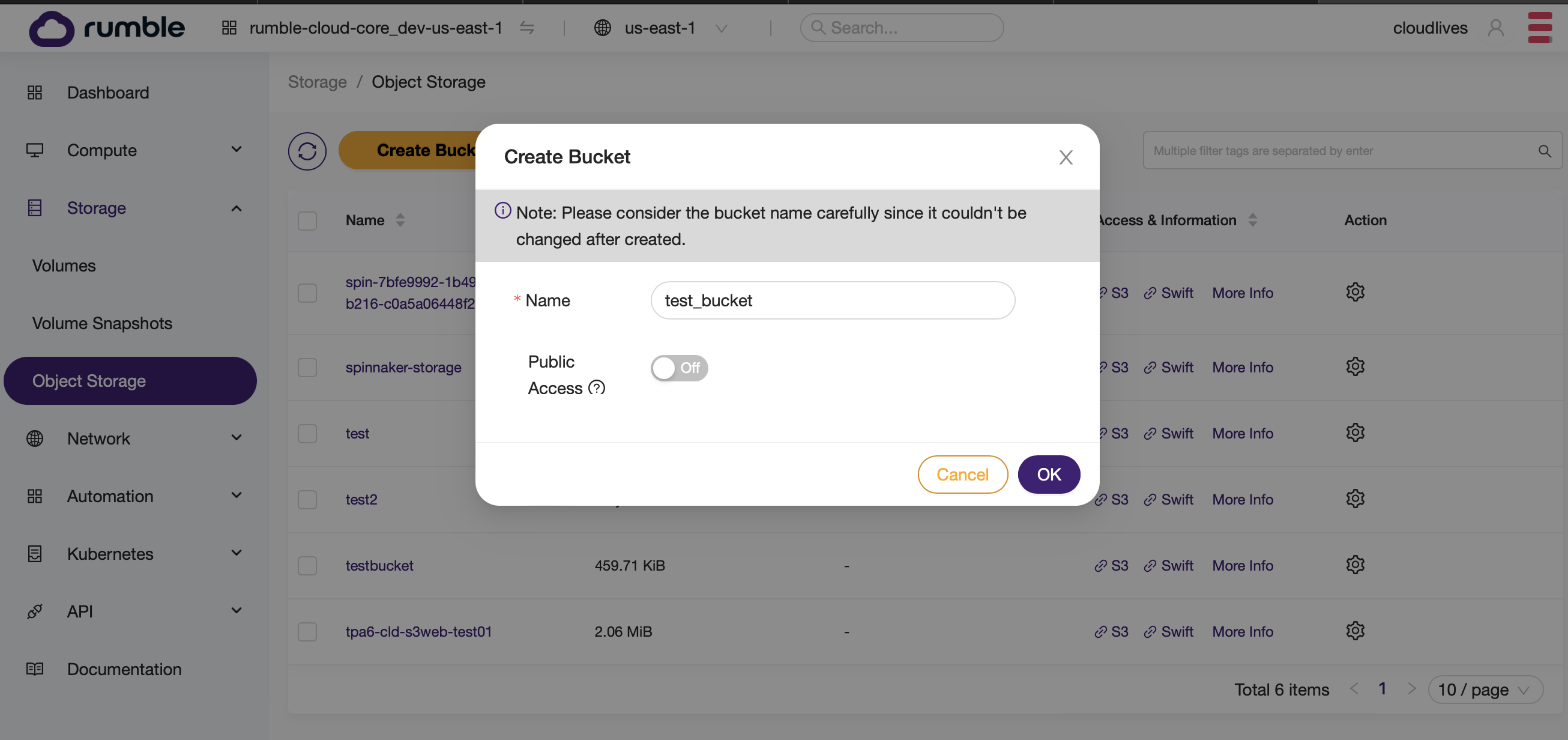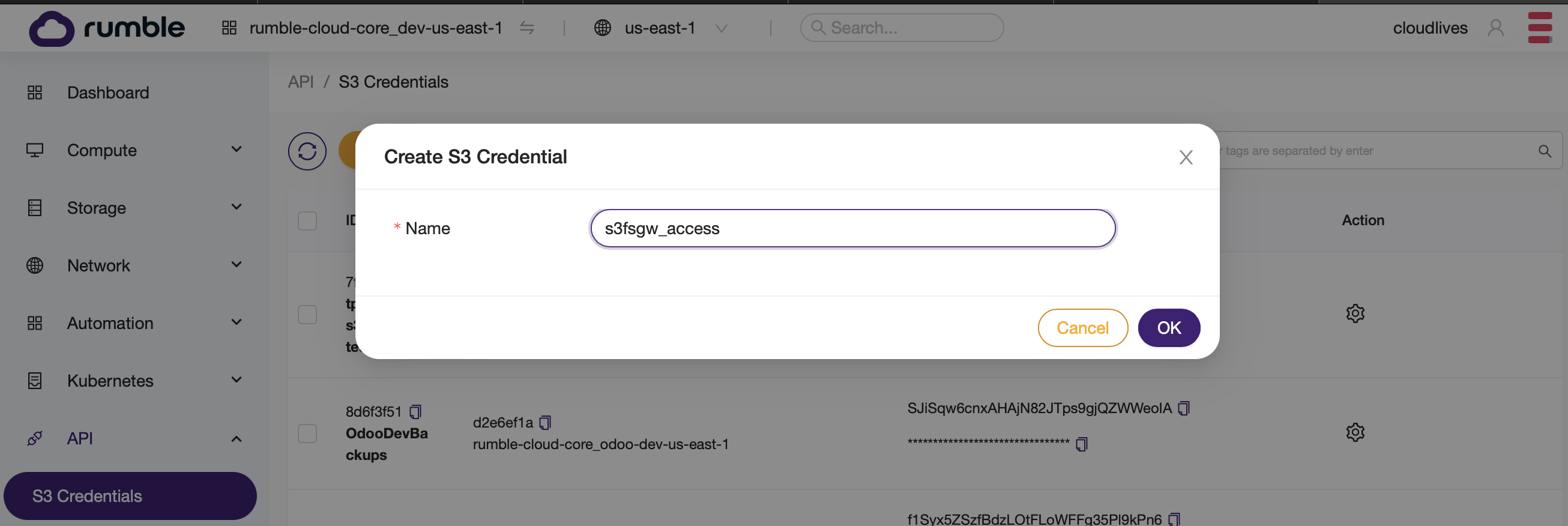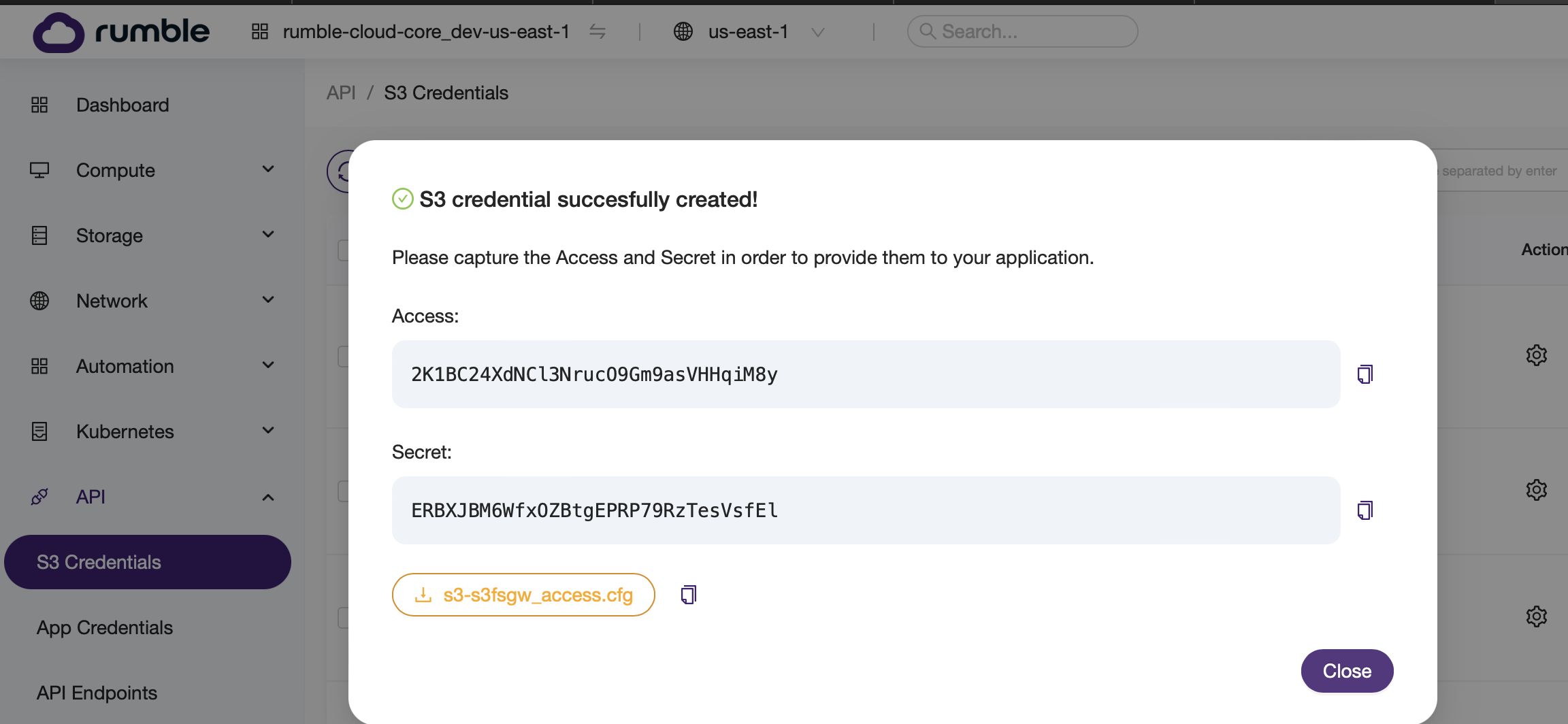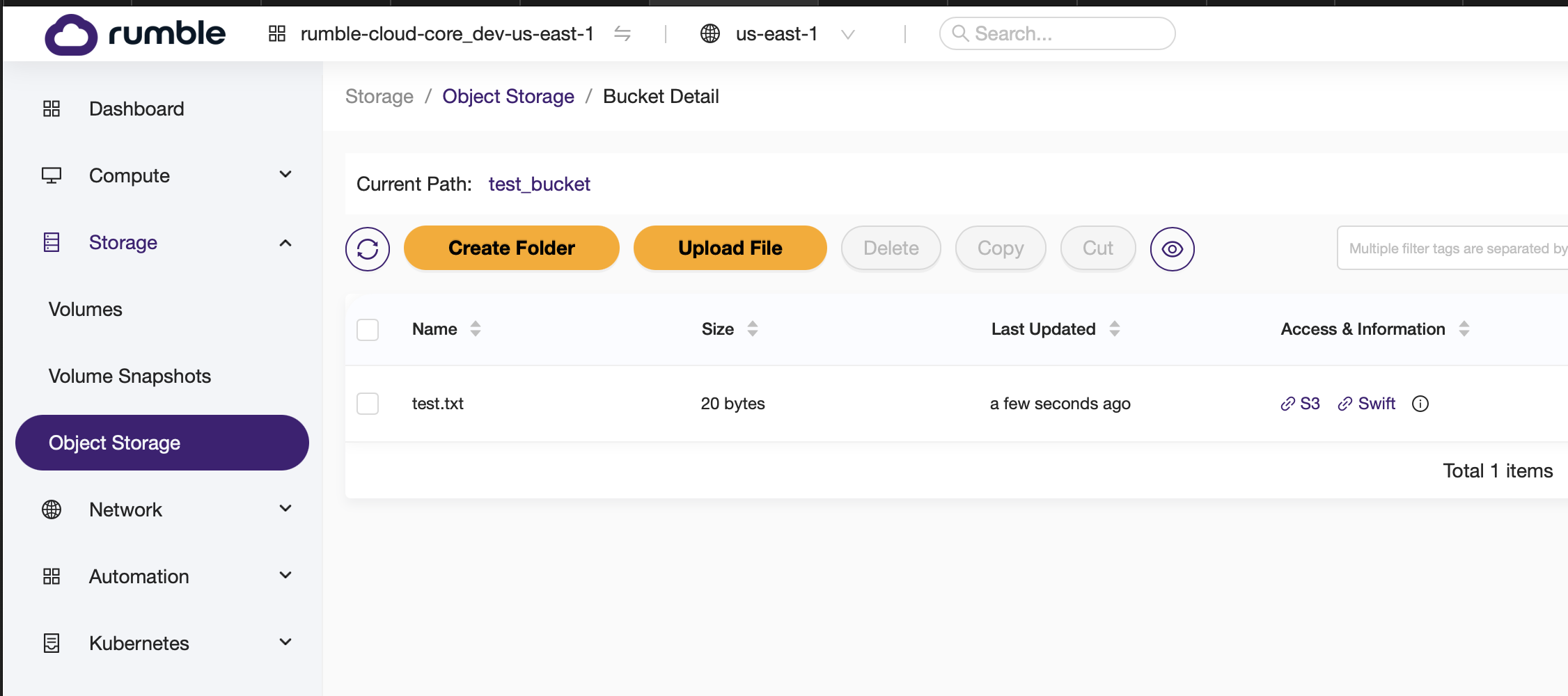Use FTP, FTPS, and SFTP¶
Rumble Cloud object storage natively supports both S3 and Swift object storage protocols for robust management of your storage needs.
| Protocol | Description | Key Features | Common Use Cases |
|---|---|---|---|
| S3 (Simple Storage Service) | Amazon's object storage protocol that has become an industry standard | - RESTful API - Strong consistency - Rich metadata support - Extensive SDK support - Versioning support |
- Web applications - Backup and archive - Big data analytics - Content delivery |
| Swift (OpenStack Object Storage) | OpenStack's object storage protocol | - RESTful API - Eventual consistency - Multi-region support - Built-in CDN capabilities - Container-based organization |
- Cloud storage - Content distribution - Data archiving - Media storage |
Sometimes when accessing certain projects and legacy systems you may need to use other protocols such as FTP, FTPS, or SFTP.
| Protocol | Description | Security | Ports | Best Use with Object Storage |
|---|---|---|---|---|
| FTP (File Transfer Protocol) | Traditional file transfer protocol | - No encryption - Passwords sent in plain text - Not recommended for public internet use |
- 20 (data) - 21 (control) |
- Legacy system integration - Internal network transfers - VPC-only deployments |
| FTPS (FTP over SSL/TLS) | Secure version of FTP using SSL/TLS encryption | - Encrypted data transfer - Encrypted authentication - Certificate-based security |
- 989 (data) - 990 (control) - Additional ports for passive mode |
- Secure file transfers - When FTP compatibility is required - Public internet transfers |
| SFTP (SSH File Transfer Protocol) | Secure file transfer protocol built on SSH | - Encrypted data transfer - Encrypted authentication - Key-based authentication support |
- 22 (single port) | - Modern secure transfers - Automated transfers - Public internet transfers |
In the article you'll learn how to setup a S3 gateway virtual machine (VM) that enables direct transfer of files to S3 through SFTP, FTPS, or FTP. These steps could also be used for other generic remote file protocol (such as NFS, SMB, etc), but with additional limitations.
Because this process mounts the S3 bucket as a directory under Linux using the S3FS utility, your object storage may look a lot like a file system. But since object storage is not designed to be a file system, not all operations will work as expected. The process described here will work well for transfering and storing files, but you should generally avoid more advanced operations like in place editing of files.
In this document we will outline a process using an Ubuntu 24.04 VM with S3FS. Other approaches using other operating systems and tools could be used equally well. For example, the same affect could be achieved with Windows using the rclone mount tool.
Setup a basic server and S3 bucket¶
- Create a Rumble Cloud account, and purchase at a plan that includes at least 1 vCPU and 1 TB of Object Storage
- Build an Ubuntu 24.04 VM using the default Ubuntu 24.04 image available no Rumble Cloud.
- You can use any flavor. We used
s1a.microin our example. - Note that smaller VM sizes have lower network egress limits in Rumble Cloud. Even the smallest VM's can trasmit up to 500 mbps. However, if you need more throughput, please upgrade to a larger VM.
- You can use any flavor. We used
- You must assign a security group to the VM that allows incoming access for the services that you want to create a gateway for. In these example, we assume you have opened at least port 22 for SSH and SFTP access. If using FTP, TCP ports 20 and 21 at least must be open. Higher TCP ports may also be required for FTP.
- Create a Bucket on Rumble Cloud.

- Create a set of access keys on Rumble Cloud.


Setup S3FS on the server, and mount the bucket¶
- Install
S3FS - Configure
S3FS - Create a directory to mount your S3 storage on
-
Add the following to your /etc/fstab file, replacing "BUCKET_NAME" with the name of the bucket you created in an earlier step.
- If your storage is in us-east-1, use:
- If your storage is in us-east-2, use:
- If your storage is in us-west-1, use:
-
Reload you systemctl to make sure fstab changes will take affect
-
Mount the storage
Test SFTP access¶
The default Rumble Cloud Ubuntu image supports SFTP out of the box, so at this point you are ready to use your gateway VM for SFTP access.
-
First verify that you bucket has no files in it.

-
Create a test file
- Transfer the test file to
- Verify the file has been successfully transferred to your object storage on Rumble Cloud

Using FTP and FTPS¶
Rumble Cloud strongly recommends against using FTP on a public internet connection. FTP sends your password in plain text. If it is necassary, it should only be used within your own VPC with private IP addresses. Setting up a VPC is out of the scope of this document. However, the S3 gateway VM procedures that we are descring here will work for a VM setup on a public IP address or one within your VCPC. FTPS can be run securely on the internet, but it is more difficult to configure, so we would recommend SFTP or direct S3 for direct access via the public internet.
FTP¶
- Install
vsftpd - Update
/etc/vsftpto enable writing files by uncommenting the linewrite_enable=YES - Restart
vsftpddaemon - FTP access requires a user with a password. Next create a user for ftp access, and add a password.
-
Test your new FTP server connection. Here is an example from an Ubuntu that uploads a file to the directory with your S3 bucket mounted. This should verify that your FTP access is setup. This assumes that you have the standard ftp command line client available on your command prompt. You can do a similar test with any FTP client available on your system if you don't have the "ftp" command line client.
Bash$ echo "Unencrypted FTP" > test.txt $ ftp s3gwftp@YOUR_IP Connected to YOUR_IPp.. 220 (vsFTPd 3.0.5) 331 Please specify the password. Password: 230 Login successful. Remote system type is UNIX. Using binary mode to transfer files. ftp> cd /opt/s3storage 250 Directory successfully changed. ftp> put test.txt local: test.txt remote: test.txt 229 Entering Extended Passive Mode (|||53701|) 150 Ok to send data. 100% |*************************| 6 96.05 KiB/s 00:00 ETA 226 Transfer complete. 6 bytes sent in 00:00 (8.45 KiB/s) ftp> exit 221 Goodbye. $ -
Verify that the file was uploaded to your S3 bucket.
FTPS¶
After following the above instructions for FTP, you can optionally enable FTPS by doing the following.
-
You will need to have a TLS certificate to use FTPS. In this example, we use the default Ubuntu self signed certificate. For additional security, you can purchase one or generate one from a free service such as Let's Encrypt.
-
Edit
/etc/vfsftp.conf: - Change
ssl_enable=NOtossl_enable=YES -
Add the line
force_local_logins_ssl=YES -
Restart vsftpd daemon
- At this point, your FTP server should only accept FTPS connections.
- Test your new FTPS server connection. Here is an example from an Ubuntu machine that uploads a file to the directory with your S3 bucket mounted. This should verify that your FTPS access is setup. Note that this example installs the "lftp" program as the standard ftp client does not support FTPS. You can do a similar test with any client that supports FTPS that is available for your system.
Bash
$ sudo apt install lftp $ echo "Encrypted FTPS" > test.txt $ lftp s3gwftp@YOUR_IP Password: lftp s3gwftp@YOUR_IP:~> set ssl:verify-certificate no lftp s3gwftp@YOUR_IP:~> cd /opt/s3storage cd ok, cwd=/opt/s3storage lftp s3gwftp@YOUR_IP:/opt/s3storage> put test.txt 5 bytes transferred lftp s3gwftp@YOUR_IP:/opt/s3storage> exit $
Conclusion¶
Using the above process you should be able to easily provide SFTP, FTP, or FTPS access to your S3 Buckets for systems that require this access. This process will work well with these protocols since they will normally only upload or download full files. Note that you could also use a similar process to provide access via NFS, SMB, or any other file sharing system. However, in those case you will have to be more cautious to try to limit yourself to operations that add or delete full files. Trying to do more advanced files operations such as online editing directly on the files may result in unexpected results.
Note that we used Ubuntu 24.04 in this example, but a similar process could be used with any other operating system including Windows based OS's, other linux distributions, etc.